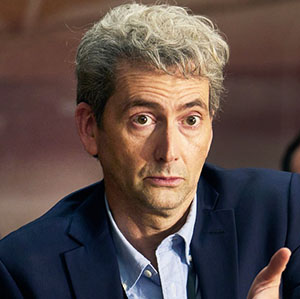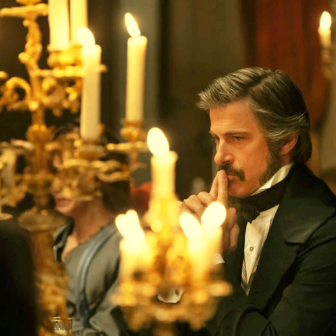The Øresund Bridge sweeps nearly eight kilometres in a dramatic curve across the strait between Sweden and Denmark. Seen at dusk from the air, its arc of moving lights forms the centre of a spectacularly beautiful panorama; beneath it, though, something very dark indeed is about to take place.
The producers of the Scandinavian crime series The Bridge warned in advance that season four opens with a scene more shocking than anything attempted previously in the series. Since the horrors are revealed in the promotional trailer, it’s no spoiler to state that the scene shows a woman buried up to her shoulders, about to be stoned to death. Yet when police officers arrive in the grey dawn to discover what has happened, they display little reaction.
Frequently described as the finest offering in the Nordic Noir repertoire, The Bridge is a strange weave of scenic brilliance and erratic scripting. Those responsible for the storyline have shown a persistent tendency to overplay their hand, steering the cast through events so extreme that they border on farce. There are times, though, when this play on the borderline between the horrible and the ludicrous is one of the series’ strengths, largely owing to the nuanced way in which Sofia Helin as Saga, the detective at the centre of it all, plays across the registers.
Saga is on the autism spectrum, high-functioning in cognitive terms and a mess when it comes to social and personal interaction. The detective with Asperger syndrome is a well-established ingredient in television crime drama, but here the distinctive element is that Saga has to apply the same deductive skills to everyday conversational exchange as she brings to her professional assessment of evidence.
With a toneless voice and a face that expresses fifty shades of puzzlement, she seems to draw us into her very thought processes. The effect is often a fusion of pathos and comedy, as in the famous scene from the first season where she propositions a guy in a bar, brusquely suggesting “sex” without any of the social preliminaries.
By the fourth season, it has become evident that some of the emotional rigidity is the consequence of scar tissue. After suffering a panic attack, Saga presents herself to a psychologist with a diagnosis at the ready: she is suffering from post-traumatic stress. Asked to elaborate, she reels off a perfunctory summary. After her mother, who had Munchausen syndrome by proxy, almost killed her younger sister, Saga made sure both her parents went to jail and took charge of her sister, who went on to commit suicide at the age of fourteen. A litany of murders, suicides and betrayals among friends and colleagues follows. Then, when her mother also commits suicide, Saga is accused of her murder. She’s just been released from jail following a retrial, having been stabbed in the neck with a broken table tennis bat on her way out.
This tragi-comic pile-up is a wry acknowledgement of the writing team’s lack of restraint. There’s no limit, it seems, to what they can throw into the mix: sinister clowns, homicidal mothers, abducted children and, of course, an infinite variety of tortures and killings. The consequence of this quite literal overkill is that we viewers don’t really care much about any of it. Even the stoning scene becomes no more than a gimmick, the first in an Agatha Christie–like series of murders, each conceived and perpetrated according to some elaborate narrative in the killer’s mind. In reality, serial killings don’t happen like that. But what does reality have to do with it?
As far as crime fiction is concerned, there are different kinds of realism. The scenic, social and psychological aspects may be based on meticulous research, leaving wider latitude in devising the course of events. The latitude is greater in television drama than in the crime novel because the camera can provide so much compensatory engagement with the actualities of the world.
If The Bridge has claims to pre-eminence in the genre of Nordic Noir, these lie in its scenic and psychological dimensions. The plot is virtually impossible to follow and frankly not worth the bother. But the scenography (combining the talents of Lotta Wihl and Lars Rickard Wiren in design and Carl Sundberg and Lars Reinholdt in camera work) is state of the art, a rendition of the noir tradition that is both televisual and contemporary. Night scenes are portrayed in brown and amber, contrasting the romance of the city as a whole with the abjection of its hidden places, those bunkers and alleyways revealed in the cold light of day. This is a world in which you are either in the half light, straining to see, or suddenly confronted with the stark clarity of a fully visible horror.
Saga’s opening scene for this season takes place in a prison, where she is seen pulling on bad clothes and shuffling across to the canteen, a shapeless figure who seems to have had the stuffing knocked out of her. She is no one — just a woman who knows how to obey rules. Back at work following her release, it is as if the trademark boots and coat are the means by which she is restored to form and able to function as an agent in the world.
Serious misjudgements about the nature and direction of the story led to the departure of one of its best actors at the end of season two, breaking up the wonderful double act between Saga and her Danish counterpart Martin, played by Kim Bodnia. Chunky, grounded and ironic, Bodnia provided the perfect foil to her obtuseness and mystique. Her replacement partner Henrik (Thure Lindhardt) is too melancholic to inject any dynamism into the relationship. As Saga, Helin holds the tension line through the eight episodes and remains the primary focus of dramatic interest. It’s a very fine performance indeed — original, witty and moving.
This final series becomes all about Saga’s inner battle as she finds herself increasingly subject to powerful and unfamiliar emotional reactions. As we are reminded in the refrain from the series’ theme song, “everything goes back to the beginning.” That’s the way with crime thrillers, and with traumatic experience. All the water that has flowed under the bridge must be traced back to its source. •




